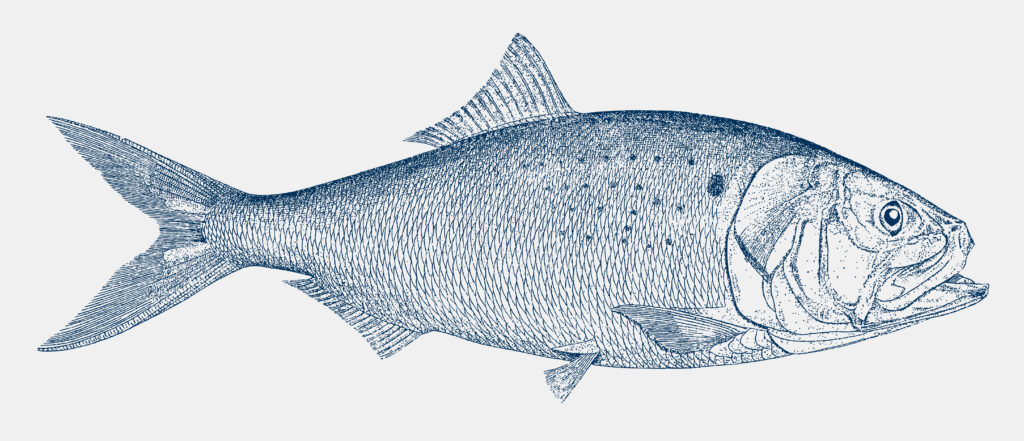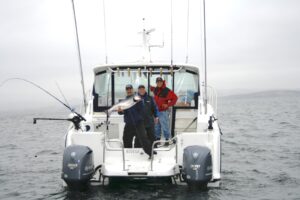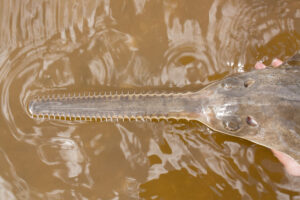
Trying to read too much fisheries news can lead one down a lot of rabbit holes. It is easy to get distracted from the overall goal of ensuring there are fish in our oceans for the future. As long as that is our main goal and we are successful, then user groups can go in the next room, put on the boxing gloves and determine who gets what share.
Healthy Ecosystems Are Built on a Solid Forage Base
In order to have healthy fish populations, we have to support healthy ecosystems and there are many components to that. Let’s look at menhaden, again. They are an extremely important part of the ecosystem for the East and Gulf Coasts. It is hard to say what the virgin or un-fished population looked like, but it had a purpose since Nature is not haphazard. The spawning stock biomass had to be substantial as the populations of all the species that foraged on them were also abundant. Does this mean that we have to leave all forage in the ocean and there cannot be a commercial harvest of menhaden? No it doesn’t. But it does mean that there has to be consideration of all the ecosystem needs and the impacts from the actual fishing process.
On the East Coast as Addendum II to the ASMFC Striped Bass plan is considered, some folks are conflating the menhaden fishery issue and management strategies for striped bass. Most folks I talk to would be happy to see more menhaden left in the ocean for a number of reasons. They also understand that the current status of striped bass is primarily due to overfishing not lack of forage. Since the largest share of the catch is recreational, they also understand the need for regulations on that catch.
Commercial Menhaden Harvest Impacts Habitat and Other Species
Many also know that fishing operations for menhaden inside the Chesapeake Bay have detrimental impacts on the benthic habitat and also have bycatch of species that are important to recreational users. Where and how the commercial catching takes place has to be managed. The normal retort is that the percentage of bycatch is minimal. Well 5 percent of hundreds of million pounds of catch begins to mount up. So an effort to further restrict the areas that menhaden can be netted in the Chesapeake is not a diversion of effort to rebuild the striped bass population. It is a separate issue and needs to be continued. It is not one or the other.
A similar scenario is happening in the Gulf of Mexico concerning the menhaden fishery there and efforts to rebuild speckled trout and redfish. In fact, it’s almost déjà vu all over again. There is a current effort to reconstruct the speckled trout population by increasing size limits and lowering bag limits. Recreational organizations are not supporting the measures that are being proposed by Gulf fisheries managers. The same management issues are also being addressed for red drum or “redfish” primarily in Louisiana. The measures being proposed by fisheries managers are being challenged by a variety of recreational interests. Their efforts against size limit changes and bag limit decreases are being seen by some as short sighted.
At the same time, these recreational organizations are continuing to press for more restrictions on the menhaden fishery in the Gulf. Critics say that these recreational organizations should accept the science advice on speckled trout and redfish and leave the menhaden fishery alone. They say the menhaden fishery is being managed sustainably and it is not overfished. Okay, but as we wrote in an earlier piece, the problem is more where and how these fish are caught rather than how many.
Recreational Anglers Must Continue to Fight for Better Regulations
The menhaden industry signed a toothless agreement saying they would abide by near-shore buffer zones to minimize the impact with benthic habitat and bycatch of a variety of nearshore species, many of which are juveniles. Their ultimate response to the agreement was, “we go where the fish are!” They also point out that they are staying within the bycatch percentage restrictions. Ok, but do you know how much tonnage 3 or 5 percent of a billion pounds is? Well, we understand and it’s why some real restrictions need to be put in place. Those restrictions could have beneficial impacts for important recreational species. But they won’t happen by wishing, so someone has to fight for them.
Right or wrong, recreational users have historically had varying opinions on fisheries management proposals. That is part of our participatory process. However, it is important that anglers stay engaged in the process and anglers are more engaged than they have ever been. That is a good thing. We may stumble along the way, but if we keep trying, we’ll get it right.









